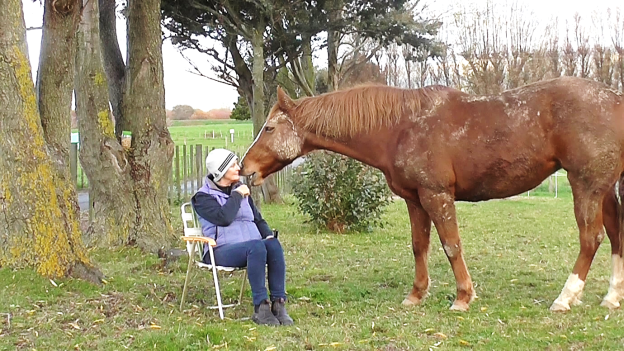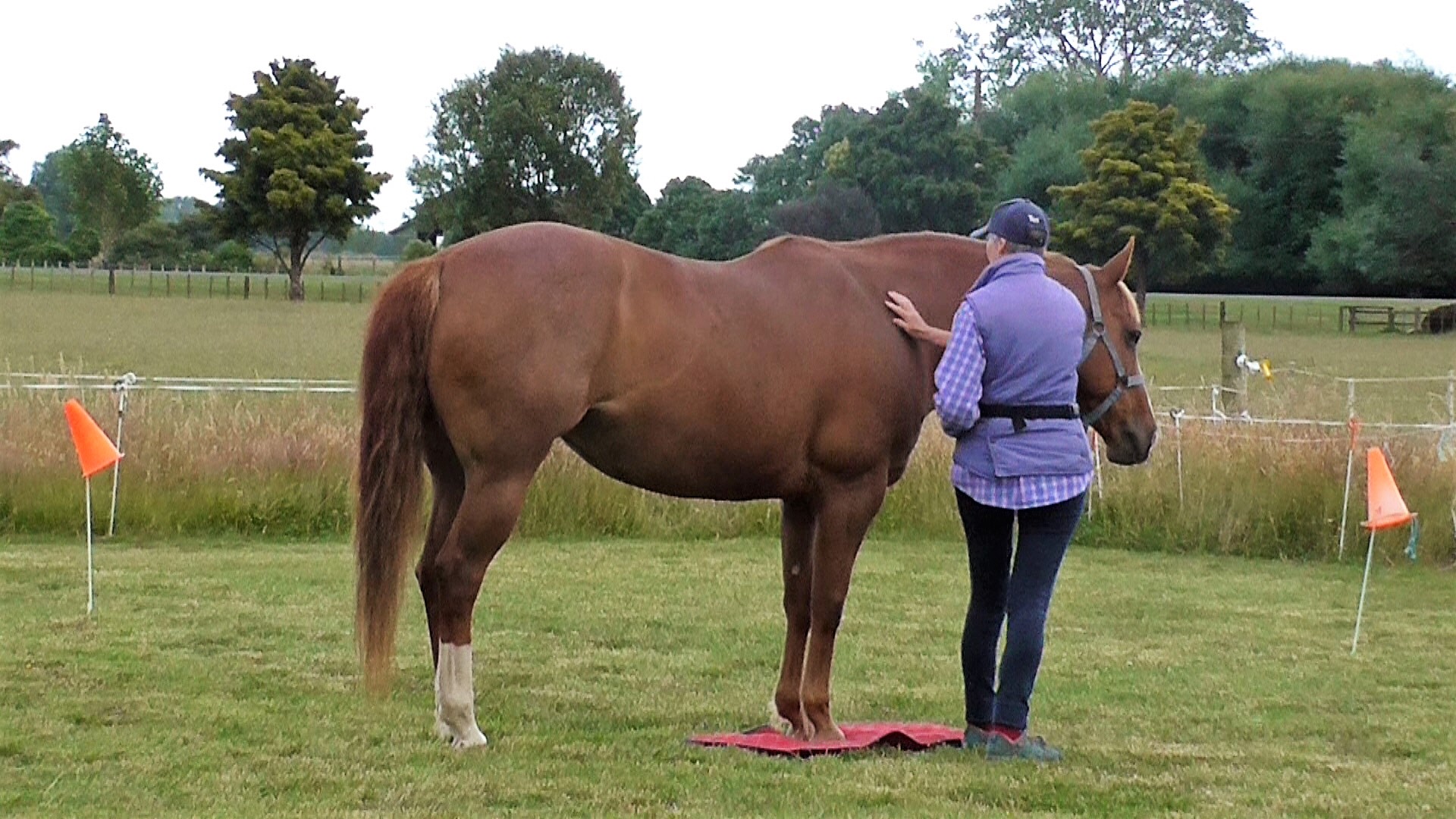Greet & Go = Acknowledging Another Group Member
Background
The Greet & Go process is based on how horses who know each other greet upon meeting. In this exercise, the horse can choose to greet us. If he decides not to greet us, nothing happens, so this exercise shows the horse that it is okay to say, ‘No, not right now’. It helps to build trust because the horse gains a sense of control in the situation.
It seems that control over one’s actions is a primary reinforcing element in life, whether one is human or any other critter. A sense of having control is probably strongly related to routine. A sense of well-being arises if we can move, eat/drink, sleep, seek shelter, choose our company (if a gregarious species) according to our daily and seasonal rhythms and our personal preferences.
Any departure from having control about what happens next induces unpleasant stress (‘distress’, as opposed to ‘eustress’, the useful stress involved with learning new things at a rate we can easily absorb). For horses, any sort of containment causes distress because they are adapted for freedom of movement over 24 hours, strong environmental awareness and the ability to flee rapidly if a worrying situation arises.
The more we can allow our horses control over their lives, the better the probability that they will be relatively comfortable in captivity and willing to form working relationships with people.
The human-horse interaction dynamic is always problematic for the horse. By introducing the Greet & Go to every meeting with a horse, we relate to him in a way that acknowledges his reality rather than imposing only our desires.
Greet & Go is an activity done every single time we meet a horse.
The Human Tendency
When I introduce this exercise to people, they invariably want to pat the horse’s face after the horse has politely put his nose on their hand. In terms of horse etiquette, I have the feeling that horses find this distinctly impolite. Most horses dislike it, especially from a stranger.
They often try to move their head away. Some horses have learned to stop people doing this by using their teeth if a warning with the ears is ignored.
As already mentioned, new horses greeting each other often put their foreheads together, check each other’s breath and push to help get the measure of the other horse. I think putting our hand onto the horse’s face might feel to them like a dominating gesture.
The Greet & Go exercise does not include any fondling of the horse’s head or ears.
The Greet & Go Process

We can do this across a fence or in with the horse. The key is to always let the horse close the last 2 inches of space. If he chooses not to connect, we walk away.

Wait with zero intent while the horse decides whether he wants to make contact or not.

Smoky making contact with the back of Bridget’s hand. We always allow the horse to close the last two inches of space between his nose and our hand.
The Greet & Go exercise is simple but profound. You can do it across a fence or while in with the horse. You approach the horse from the front in a quiet, relaxed, friendly manner and before you quite reach him, you hold out your arm with a lightly curled fist, and invite the horse to touch the back of your hand. Your hand stands in as another horse’s nose. Horses use their noses to explore like we use our hands.
As soon as the horse has touched your hand, which is the Greet, you quietly walk away. Walking away is the Go part of the process. You approach the horse, Greet, then immediately do the opposite, Go, by walking away. You are showing the horse that you respect his space and his place in the universe and in your life. You no longer approach his bubble only when you want to halter him and make him do things.
Horses appreciate the opportunity to greet us politely. The act of turning and walking away (Go) is a neutral act another horse might do, i.e. touch noses and share breath to say hello and then move away to mind his own business because he is secure in the relationship. It shows that neither party is looking for any sort of further interaction or confrontation.
The whole dynamic is like the friendly recognition we give to colleagues as we walk past them at work or when we briefly greet a neighbor out shopping.
Here is an important point that runs through all our interactions with a horse. If the horse comes into our space (our bubble) of his free will, he needs to do so politely. If he’s not polite, it’s fair for us to send him away. If we go into our horse’s space (bubble) we need to do so politely. If we intend to ask him to do something, we need to ask politely, giving the horse time to think about our signal and respond to it.
Do the Greet & Go routine as often as you can during your usual interactions with your horse. Approach the horse from the front offering your outstretched hand. A horse that wants to greet you will put his nose on your hand. As soon as he does, walk away and carry on doing what you were doing. If you clean your own paddocks every day, it is a nice way of recognizing the horse and letting him know it is not time to play clicker games.

Bridget and Boots having a greeting during Quiet Sharing of Time and Space.

Stopping for a greeting during a filming session.
If the horse does not want to put his nose on your hand, that’s okay. Go away and carry on what you were doing or go do something else. The horse will appreciate that you understood his feelings at that moment in time.
The greeting is also a good way to begin further contact, such as clicker training, grooming or getting ready for an activity.
If your horse does not want to greet you, you have instant feedback on his mood of the moment and can adjust your plans accordingly.
If the horse does not want to greet you (ignores you or walks off) you can choose to carry on the interaction by walking a loop away from the horse and approaching him again, creating another opportunity to offer your hand. Allowing the horse to say, “No,” without consequences builds his self-confidence.
It may take just a couple of approaches before he is willing to greet you, or it may take more than ten relaxed approaches spread over one or more sessions. Eventually he will. Meanwhile, you are learning how to relax yourself out of frustration.
Relaxing Ourselves out of Frustration
- Pause and turn away from the horse.
- Breathe deeply and slowly, in and out.
- Roll your shoulders slowly until they can stay in a relaxed, down position.
- Gently bend your neck up and down, right and left.
- Stretch both arms straight up and down again – slowly.
- Smile.
- If the situation allows, sit for a while in the horse’s area, watching the clouds, noting your breathing, meditating.
- Walk around the horse’s enclosure, noting specifics. If the horse comes over to you at any point, Greet & Go.
- Breathe while doing all the above.
- Sometimes it is good to quietly finish the session and go away.
The Horse Unwilling to Greet the Human
Horses with unknown histories can have all sorts of reasons for not wanting to greet a person. If you make five or ten approaches every day and they are all rejected, keep a written log. At some point, it will happen. Celebrate quietly and Go away. If you feed hay, offer to Greet & Go before you put down the hay.
Remember, horses have all day every day. If you have the time and good humor to persist, the horse will eventually greet you. A treat offered after the greeting (put on the ground if the horse does not accept food from your hand) can amplify the importance of your offer to greet.
If you don’t have all day, you might decide to simply go away. The horse misses out on attention and treats. Maybe you can openly give your treats to another horse before you go. Horses will observe this and think on it overnight. Or you can move away and put a treat on the grass or in a feed bin well away from the horse before you leave. The horse will also think about that.
If the horse usually moves away at your approach, you probably need to go back and spend more time with Quiet Sharing of Time and Space to build the bond. Most likely he has benefited from human avoidance behavior in the past – he was able to control the interaction by moving away.
If he seems to have an “I’d rather avoid you” habit, there are ways of making yourself more interesting. If they are around, you could pay attention to other horses or pets or things. Sit down and eat an apple or a carrot. Go back to Quiet Sharing of Time and Space and ignore him.
If you’ve set up the usual environment for a one-on-one date, the horse may initiate an interaction as more interesting than ignoring you. Whenever something seems broken, go back to Quiet Sharing of Time and Space to re-forge the bond.
You can also, if your environment allows, hide behind trees, buildings, vehicles or barrels to pique your horse’s curiosity. Sitting or reclining on the ground changes our profile and may encourage curiosity. I had great fun running from tree to tree and hiding for a while behind each one. My horse couldn’t stand watching this novelty without coming over to investigate. Make yourself interesting. Seek ideas outside the square.
The point of the Greet & Go exercise is that the horse is free to choose whether he wants to greet you. If you’ve approached him several times and he’s wandered away rather than touch your outstretched hand, you are receiving a clear message.
The challenge becomes to consciously change your behavior and observe closely to see how the horse responds. How does his behavior change when you act differently? Such experimentation is fun. There is no right and wrong. At any time, your horse unbounded by ropes is free to choose what he thinks is the best thing to do at that moment.
These exercises allow you to see what works to your advantage and what doesn’t. It’s very different from making horses do things when you decide they’ll do it because you have a rope on them, and/or they are contained in a small area.
Used every time you approach your horse; the Greet & Go exercise helps build a powerful connection. If you include a gift with the greeting (food treat or a scratch and rub and eventually putting on the halter and going for a grazing walk), it becomes even more powerful. If you do clicker training, the Greet habit can be strengthened using click&treat whenever the horse approaches you at the beginning of a clicker training session.
Greet & Go








